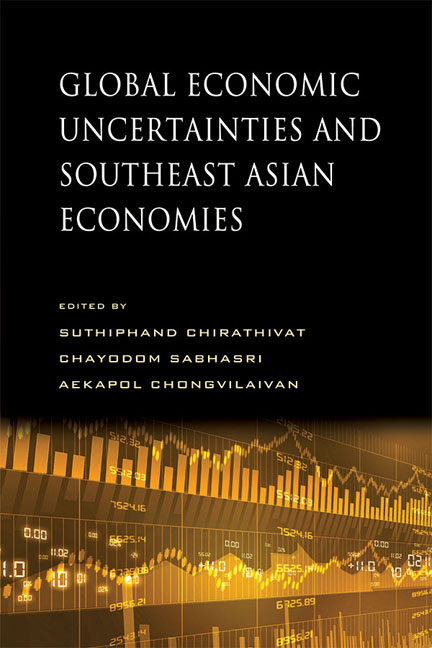Book contents
- Frontmatter
- Contents
- Preface
- Contributors
- 1 Challenges Facing a Globally Connected ASEAN
- 2 Fragile Balance of Payment in Indonesia under Global Economic Uncertainties
- 3 Malaysia in the Midst of Global Economic Uncertainties
- 4 Singapore: Reinventing Itself amid Global Economic Uncertainties
- 5 Thailand: Dependency or Diversification?
- 6 Vietnam's Economic Experience since WTO Accession
- 7 Global Economic Imbalances and Reform Policy: Evidence from Asian Economies
- 8 Foreign Exchange Rate Adjustment Policies in Asia
- 9 Monetary and Financial Architectures for ASEAN+
- 10 Global Uncertainties: Implications for the ASEAN Community
- Index
8 - Foreign Exchange Rate Adjustment Policies in Asia
Published online by Cambridge University Press: 22 July 2017
- Frontmatter
- Contents
- Preface
- Contributors
- 1 Challenges Facing a Globally Connected ASEAN
- 2 Fragile Balance of Payment in Indonesia under Global Economic Uncertainties
- 3 Malaysia in the Midst of Global Economic Uncertainties
- 4 Singapore: Reinventing Itself amid Global Economic Uncertainties
- 5 Thailand: Dependency or Diversification?
- 6 Vietnam's Economic Experience since WTO Accession
- 7 Global Economic Imbalances and Reform Policy: Evidence from Asian Economies
- 8 Foreign Exchange Rate Adjustment Policies in Asia
- 9 Monetary and Financial Architectures for ASEAN+
- 10 Global Uncertainties: Implications for the ASEAN Community
- Index
Summary
INTRODUCTION
Global imbalances emerged in the world economy after the 1997 Asian financial and currency crises, and policymakers and academics have since been concerned about the consequences and how to correct them. Subsequently, in 2008 the financial crisis erupted in the United States and spread to other developed countries, resulting in a deep and prolonged recession that has continued to plague the global economy until today. Most economists believe that the global imbalances are one of the major factors to have contributed to the crisis. There has been excessive consumption and deficits in current accounts of major industrial countries, while large surpluses and insufficient consumption have been observed in the emerging economies, mostly in East and Southeast Asia. Half a decade has passed since the 2008 crisis began, but the global imbalances remain. The large industrial countries together with major emerging economies (the G-20) initiated many meetings to coordinate international macroeconomic policies aimed at reducing the imbalances. All have agreed that exchange rates and macroeconomic adjustments should be made, but there is no agreement on who should take the action.
Before the 2008 crisis, neither the surplus nor the deficit countries were willing to adjust their exchange rates or macroeconomic policies to reduce the global imbalances. The Asian countries have been criticized for their continued pursuit of export-oriented policies which have rewarded them with a very rapid and successful growth performance over the past decades. Hausmann et al. (2004) claim that the rapid growth of trade and employment was associated with depreciation of these countries’ exchange rates in real terms. That is, once these countries shifted their policies towards an export orientation, attention was paid to maintaining their real exchange rates favourable to exports in order to achieve desirable rates of output and employment growth. On one hand, the relatively low real exchange rate enabled their exports to be attractive in the world markets; on the other, it prevented their imports from growing too fast. In a nutshell, currency appreciation or, to be more precise, attempts to keep real exchange rates from appreciation, have made it possible for Asian economies to pursue an export-led growth strategy and to continue to mount foreign reserves.
In 2005 the U.S. government strongly urged the country with the most current account surplus — China — to revalue its currency on the belief that the yuan was substantially undervalued. .
- Type
- Chapter
- Information
- Global Economic Uncertainties and Southeast Asian Economies , pp. 174 - 217Publisher: ISEAS–Yusof Ishak InstitutePrint publication year: 2015



